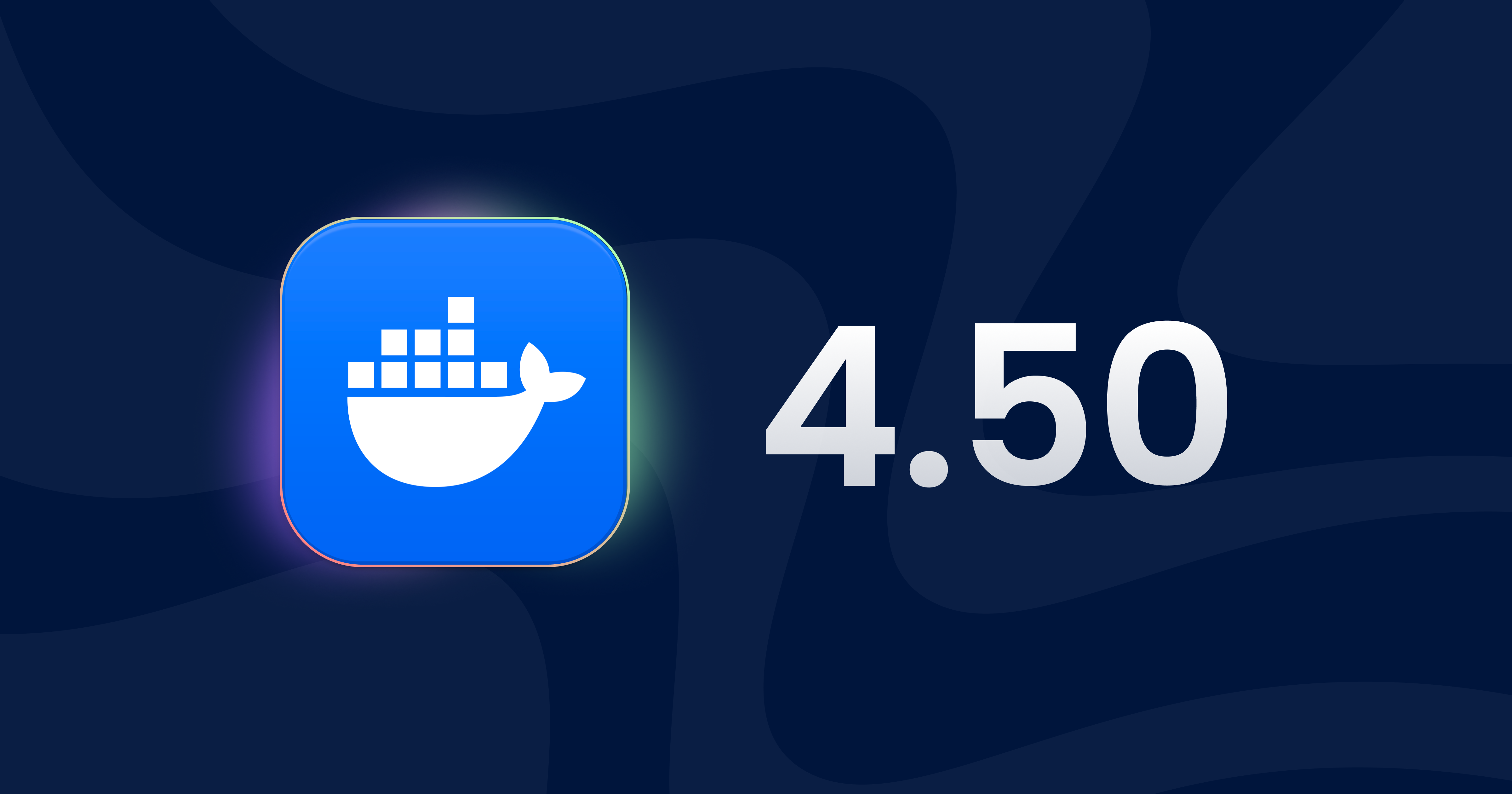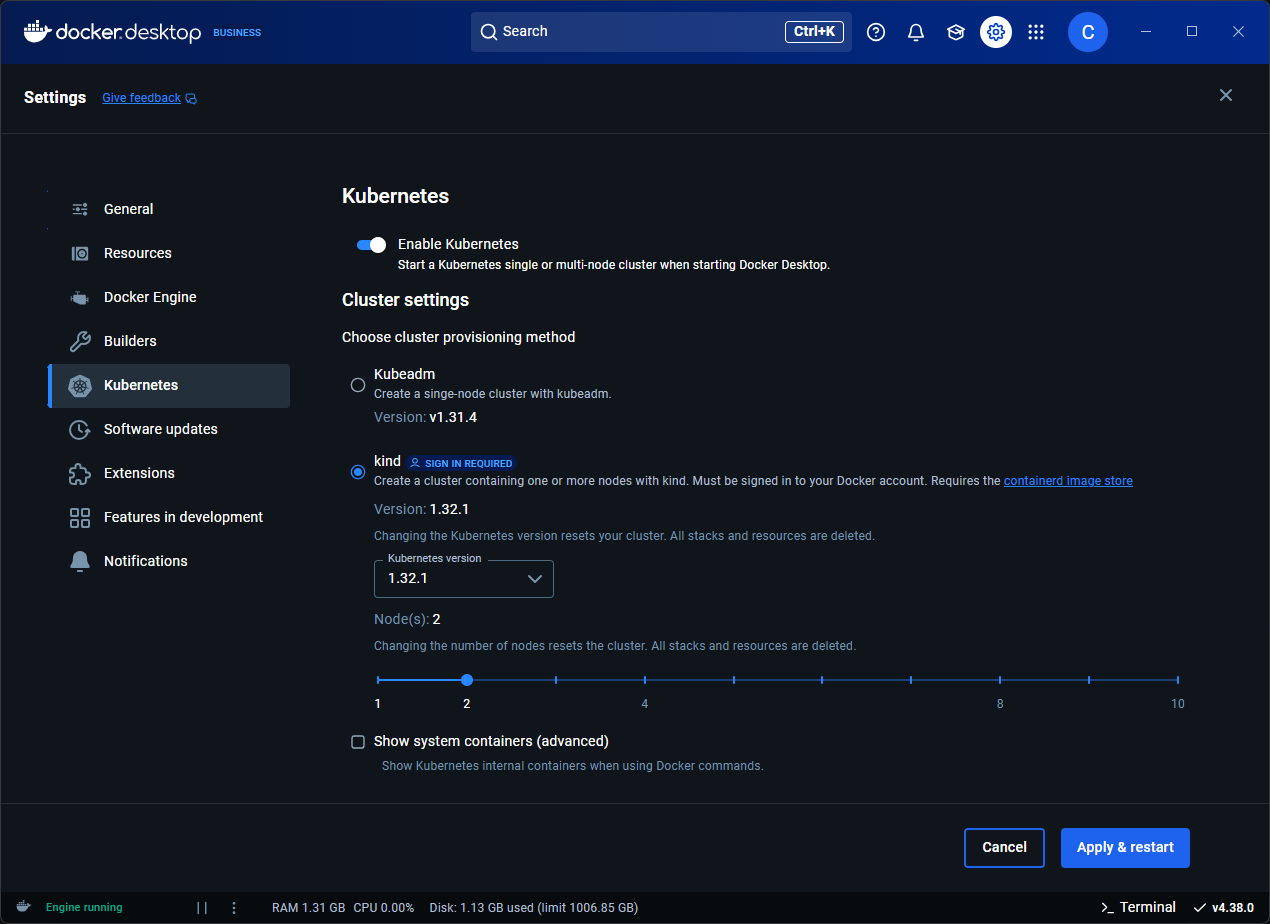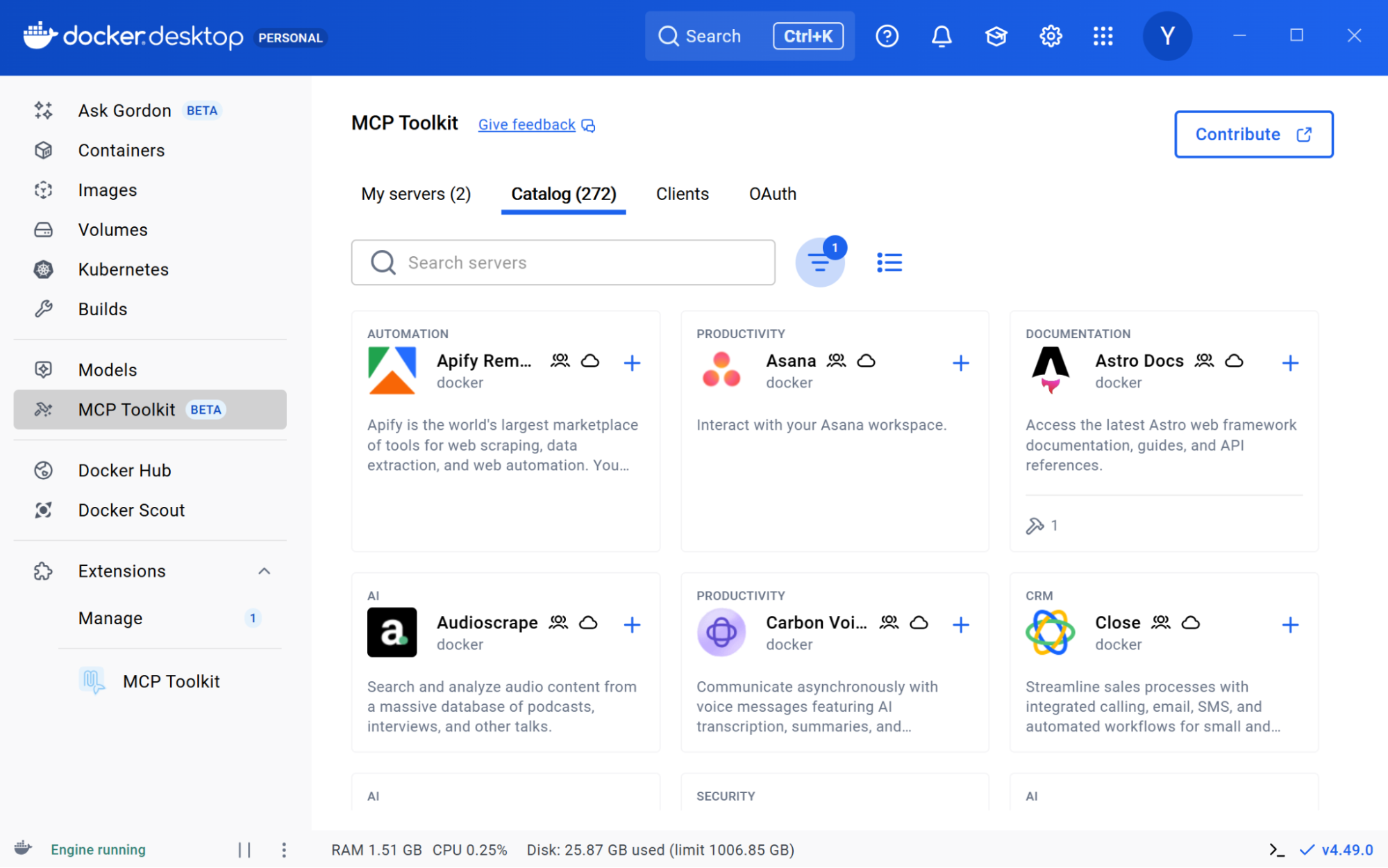Docker Desktop 4.50 represents a major leap forward in how development teams build, secure, and ship software. Across the last several releases, we’ve delivered meaningful improvements that directly address the challenges you face every day: faster debugging workflows, enterprise-grade security controls that don’t get in your way, and seamless AI integration that makes modern development accessible to every team member.
Whether you’re debugging a build failure at 2 AM, managing security policies across distributed teams, or leveraging AI capabilities to build your applications, Docker Desktop delivers clear, real-world value that keeps your workflows moving and your infrastructure secure.

Accelerating Daily Development: Productivity and Control for Every Developer
Modern development teams face mounting pressures: complex multi-service applications, frequent context switching between tools, inconsistent local environments, and the constant need to balance productivity with security and governance requirements. For principal engineers managing these challenges, the friction of daily development workflows can significantly impact team velocity and code quality.
Docker Desktop addresses these challenges head-on by delivering seamless experiences that eliminate friction and giving organizations the control necessary to maintain security and compliance without slowing teams down.
Seamless Developer Experiences
Docker Debug is now free for all users, removing barriers to troubleshooting and making it easier for every developer on your team to diagnose issues quickly. The enhanced IDE integration goes deeper than ever before: the Dockerfile debugger in the VSCode Extension enables developers to step through build processes directly within their familiar editing environment, reducing the cognitive overhead of switching between tools. Whether you’re using VSCode, Cursor, or other popular editors, Docker Desktop integrates naturally into your existing workflow. For Windows-based enterprises, Docker Desktop’s ongoing engineering investments are delivering significant stability improvements with WSL2 integration, ensuring consistent performance for development teams at scale.
Getting applications from local development to production environments requires reducing the gap between how developers work locally and how applications run at scale. Compose to Kubernetes capabilities enable teams to translate local multi-service applications into production-ready Kubernetes deployments, while cagent provides a toolkit for running and developing agents that simplifies the development process. Whether you’re orchestrating containerized microservices or developing agentic AI workflows, Docker Desktop accelerates the path from experimentation to production deployment.
Enterprise-Level Control and Governance
For organizations requiring centralized management, Docker Desktop delivers enterprise-grade capabilities that maintain security without sacrificing developer autonomy. Administrators can set proxy settings via macOS configuration profiles, and can specify PAC files and Embedded PAC scripts with installer flags for macOS and Windows Docker, ensuring corporate network policies are automatically enforced during deployment without requiring manual developer configuration, further extending enterprise policy enforcement.
A faster release cadence with continuous updates ensures every developer runs the latest stable version with critical security patches, eliminating the traditional tension between IT requirements and developer productivity. The Kubernetes Dashboard is now part of the left navigation, making it easier to find and use.
Kind (k8s) Enterprise Support brings production-grade Kubernetes tooling to local development, enabling teams to test complex orchestration scenarios before deployment.

Figure 1: K8 Settings
Together, these capabilities build on Docker Desktop’s position as the foundation for modern development, adding enterprise-grade management that scales with your organization’s needs. You get the visibility and control that enterprise architecture teams require while preserving the speed and flexibility that keeps developers productive.
Securing Container Workloads: Enterprise-Grade Protection Without Sacrificing Speed
As containerized applications move from development to production and AI workloads proliferate across enterprises, security teams face a critical challenge: how do you enforce rigorous security controls without creating bottlenecks that slow development velocity? Traditional approaches often force organizations to choose between security and speed, but that’s a false choice that puts both innovation and infrastructure at risk.
Docker Desktop’s recent releases address this tension directly, delivering enterprise-grade security controls that operate transparently within developer workflows. These aren’t afterthought features; they’re foundational protections designed to give security and platform teams confidence at scale while keeping developers productive.
Granular Control Over Container Behavior
Enforce Local Port Bindings prevents services running in Docker Desktop from being exposed across the local network, ensuring developers maintain network isolation during local development while retaining full functionality. For teams in regulated industries where network segmentation requirements extend to development environments, this capability helps maintain compliance standards without disrupting developer workflows.
Building on Secure Foundations
These runtime protections work in tandem with secure container foundations. Docker’s new Hardened Images, secure, minimal, production-ready container images maintained by Docker with near-zero CVEs and enterprise SLA backing. Recent updates introduced unlimited catalog pricing and the addition of Helm charts to the catalog. We also outlined Docker’s five pillars for Software Supply Chain Security, delivering transparency and eliminating the endless CVE remediation cycle. While Hardened Images are available as a separate add-on, they’re purpose-built to extend the secure-by-default foundation that Docker Desktop provides, giving teams a comprehensive approach to container security from development through production.
Seamless Enterprise Policy Integrations
The Docker CLI now gracefully handles certificates issued by non-conforming certificate authorities (CAs) that use negative serial numbers. While the X.509 standard specifies that certificate serial numbers must be positive, some enterprise PKI systems still produce certificates that violate this rule. Previously, organizations had to choose between adhering to their CA configuration and maintaining Docker compatibility, a frustrating trade-off that often led to insecure workarounds. Now, Docker Desktop works seamlessly with enterprise certificate infrastructure, ensuring developers can authenticate to private registries without security teams compromising their PKI standards.
These improvements reflect Docker’s commitment to being secure by default. Rather than treating security as a feature developers must remember to enable, Docker Desktop builds protection into the platform itself, giving enterprises the confidence to scale container adoption while maintaining the developer experience that drives innovation.
Unlocking AI Development: Making Model Context Protocol (MCP)Accessible for Every Developer
As AI-native development becomes central to modern software engineering, developers face a critical challenge: integrating AI capabilities into their workflows shouldn’t require extensive configuration knowledge or create friction that slows teams down. The Model Context Protocol (MCP) offers powerful capabilities for connecting AI agents to development tools and data sources, but accessing and managing these integrations has historically been complex, creating barriers to adoption, especially for teams with varying technical expertise.
Docker is addressing these challenges directly by making MCP integration seamless and secure within Docker Desktop.
Guided Onboarding Through Learning Center and MCP Toolkit Walkthroughs and Improved MCP Server Discovery
Understanding that accessibility drives adoption, Docker has introduced a redesigned onboarding experience through the Learning Center. The new MCP Toolkit Walkthroughs guide teams through complex setup processes step-by-step, ensuring that engineers of all skill levels can confidently adopt AI-powered workflows. Further, Docker’s MCP Server Discovery feature simplifies discovery by enabling developers to search, filter, and sort available MCP servers efficiently. By eliminating the knowledge barriers and frictions around discovery, these improvements accelerate time to productivity and help organizations scale AI development practices across their teams.
Expanded Catalog: 270+ MCP Servers and Growing
The Docker MCP Catalog now includes over 270 MCP servers, with support for more than 60 remote servers. We’ve also added one-click connections for popular clients like Claude Code and Codex, making it easier than ever to supercharge your AI coding agents with powerful MCP tools. Getting started takes just a few clicks.
Remote MCP Server Support with Built-In OAuth
Connecting to MCP servers has traditionally meant dealing with manual tokens, fragile config files, and scattered credential management. It’s frustrating, especially for developers new to these workflows, who often don’t know where to find the right credentials in third-party tools. With the latest update to the Docker MCP Toolkit, developers can now securely connect to 60+ remote MCP servers, including Notion and Linear, using built-in OAuth support. This update goes beyond convenience; it lays the foundation for a more connected, intelligent, and automated developer experience, all within Docker Desktop. Read more about connecting to remote MCP servers.

Figure 2: Docker MCP Toolkit now supports remote MCP Servers with OAuth built-in
Smarter, More Efficient, and More Capable Agents with Dynamic MCPs
In this release, we’re introducing dynamic MCPs, a major step forward in enabling AI agents to discover, configure, and compose tools autonomously. Previously, integrating MCP servers required manual setup and static configurations. Now, with new features like Smart Search and Tool Composition, agents can search the MCP Catalog, pull only the tools they need, and even generate code to compose multi-tool workflows, all within a secure, sandboxed environment. These enhancements not only increase agent autonomy but also improve performance by reducing token usage and minimizing context bloat. Ultimately, this leads to less context switching and more focused time for developers. Read more about dynamic MCPs.
Together, these advancements represent Docker’s commitment to making AI-native development accessible and practical for development teams of any size.
Conclusion: Committed to Your Development Success
The innovations across Docker Desktop 4.45 through 4.50 reinforce our commitment to being the development solution teams rely on every day, for every workflow, at any scale.
We’ve made daily development faster and more integrated, with free debugging tools, native IDE support, and enterprise governance that actually works. We’ve strengthened security with controls that protect your infrastructure without creating bottlenecks. And we’ve made AI development accessible, turning complex integrations into guided experiences that accelerate your team’s capabilities. The impact is measurable. Independent research from theCUBE found that Docker Desktop users achieve 50% faster build times and reclaim 10-40+ hours per developer each month, time that goes directly back into innovation
This is Docker Desktop operating as your indispensable foundation: giving developers the tools they need to stay productive, giving security teams the controls they need to stay protected, and giving organizations the confidence they need to innovate at scale.
As we continue our accelerated release cadence, expect Docker to keep delivering the features that matter most to how you build, ship, and run modern applications. We’re committed to being the solution you can count on today and as your needs evolve.
Upgrade to the latest Docker Desktop now →
Learn more
- Subscribe to the Docker Navigator Newsletter
- Read theCUBE research report
- Explore the MCP Catalog: Discover containerized, security-hardened MCP servers
- Explore cagent and give it a ⭐ to follow along as it evolves
- New to Docker? Create an account.
- Have questions? The Docker community is here to help.









